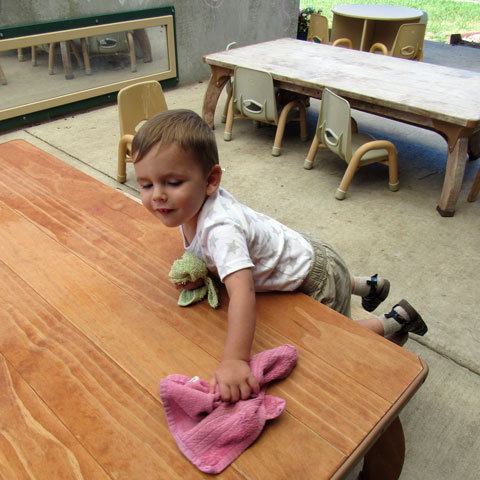Heather Goergen and Rachel Ratliff
Heartland Community College Child Development Lab
Normal, IL
2022
The Cleaning Project took place over a two-month period in the infant-toddler room at the Heartland Community College Child Development Lab in Normal. The Child Development Lab is a full-day, inclusive center. Five to six children ranging in age from 6 months to 3 years old participated. As co-teachers, we developed this project with the children.
Phase 1: Beginning the Project
We began the Cleaning Project based on interest we observed in the children. Many of them loved to help the teachers with cleaning the classroom. This included wiping off tables with spray bottles, washrags, and paper towels (see Figure 1). They also showed interest in sweeping with the brooms and dustpans. The children were able to represent their beginning knowledge and experiences on the topic both verbally and nonverbally. They were able to say words such as broom, sweep, trash, and towel. Despite their young age, many knew how to correctly use the tools. For example, they could spray the spray bottle, wipe with a towel, sweep with the broom, move dirt toward the dustpan, and dump the dustpan into the garbage can.
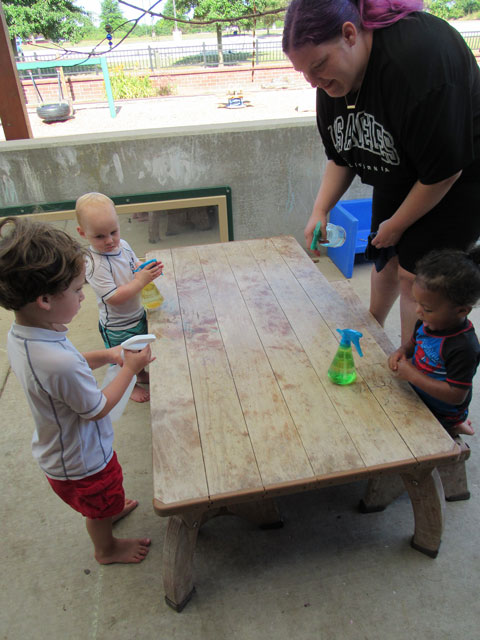
We kicked off the project by creating a teacher web, adding observations and comments from the children. We added their knowledge to the web as we heard more words and noticed more interests forming (see Figure 2).
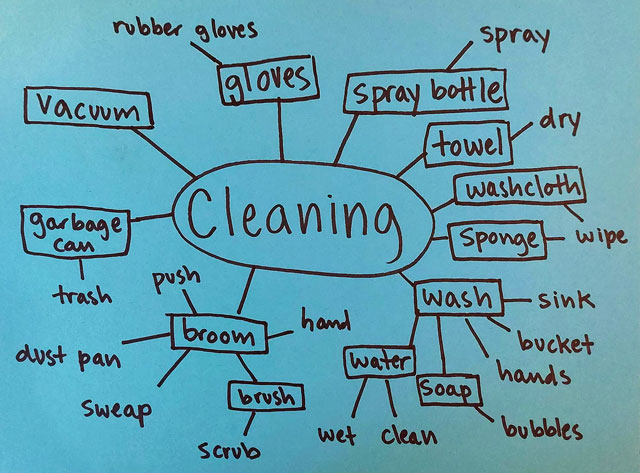
After gathering this information, we introduced the children to a variety of nonfiction books about cleaning. Finally, we added various cleaning items to our housekeeping area for the children to explore, including brooms, dustpans, washrags, empty soap containers, paper towels, a mini garbage can, and pails (see Figure 3).
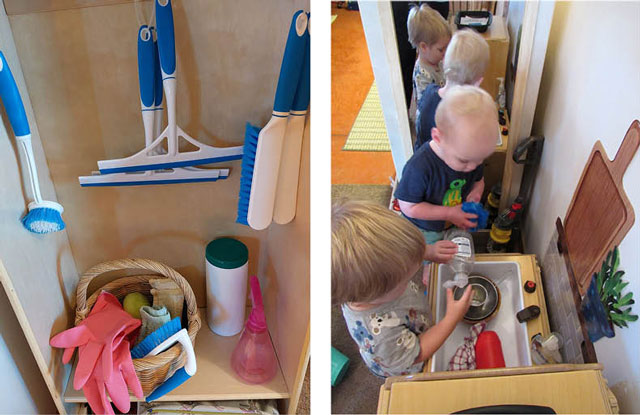
The children were drawn to the new cleaning items immediately and used them throughout the day without being prompted. We were surprised to see most of the children using the items in ways that they may have observed adults using them both at home and in the classroom. We would informally ask questions about the tools they were using, saying the words associated with those items. We took pictures and created a picture and word book that included a picture of the tool and its name.
Overall, we approached the project as an exploration with no predetermined expectations. We watched the children’s curiosity grow and change and adjusted the project to follow their lead. We introduced new items and experiences to help them practice using the different cleaning tools. Some of the experiences that were included in the general classroom were child-led and others were more teacher-led and required some supervision. For example, broom painting and vacuuming required teacher supervision.
Phase 2: Developing the Project
The children investigated a vast array of cleaning tools throughout the project. We rearranged our housekeeping area to integrate real cleaning tools in a more authentic, homelike way that the children could access during play. We incorporated the cleaning tools into activities each day, supporting child-led experiences that provided opportunities for independence while at the same time encouraging them to care for our classroom and school by working together. For example, the children used spray bottles, squeegees, sponges, buckets, and washcloths to clean the school windows by the playground. They also used scrub brushes and soapy water to clean our wagons (see Figure 4).
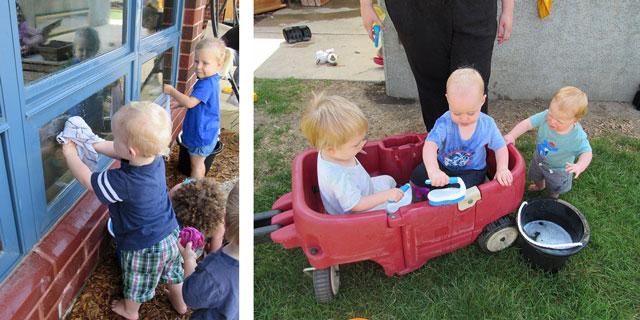
After spending a few weeks investigating, we invited our school maintenance team to bring their cleaning cart to show the children. The presentation was kept brief to accommodate the young age group. The entire infant-toddler group from all four classrooms attended the demonstration. The maintenance team not only brought their cart, but they spent time showing the children the different tools and supplies they used and explained what they were used for. They also briefly discussed chemical safety and even conducted an experiment for the children to observe. They showed how dish soap repels pepper floating on top of water to show “soap scaring away dirt and germs.” The children were fascinated and engaged by the maintenance team’s presentation (see Figure 5).
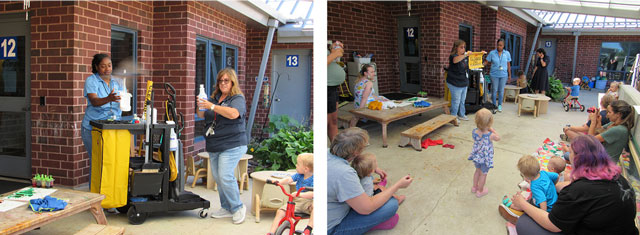
We incorporated classroom cleaning tools into some teacher-led fine arts activities. For example, we used push brooms and scratchy sponges as painting tools (see Figure 6). We also incorporated songs, poems, and dances about cleaning throughout the project. The children’s experiences increased their confidence in using cleaning tools and strengthened the relationship between the children and their teachers through these interactions. Many of the experiences provided were accessible to the variety of ages in our classroom as well.

We have daily communication with the parents of our children, so we both formally and informally kept parents involved during the entire project. When we noticed an interest forming about cleaning, we sent out an email letting parents know that we were beginning a project and encouraged them to share any related interests or experiences they noticed at home. We also sent out picture pages throughout the week, so we were able to provide parents with updates and pictures of their children at each stage in the process. We also displayed our web and pictures/write-ups from the project on a wall outside our classroom. Some parents would use this display as a conversation starter with their children at drop-off and pickup times.
We also used our local public library as a resource for age-appropriate, cleaning-related books for the project. Our library offers “teacher packs” that are put together by library staff and contain materials they offer on a chosen subject. Our library created a great pack for us with a wide variety of books. The children especially gravitated toward a book about custodians, which helped create a concrete connection between our investigation and our guest expert experience (see Figure 7).
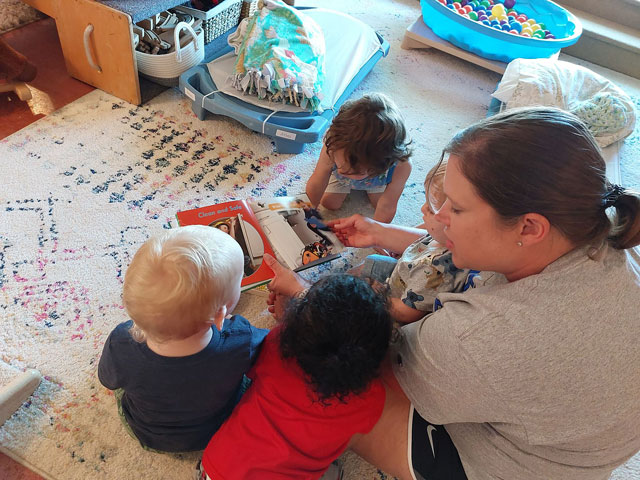
Below is a list of all of the cleaning books that were included in our library pack.
Cleaning Book List
- Why Do I Have to Make My Bed? (2011), Wade Bradford
- Max Cleans Up (2002), Rosemary Wells
- Clean-Up Time (2008), Elizabeth Verdick
- Clean It! (2010), Georgie Birkett
- Clifford’s Spring Clean-Up (1997), Norman Bridwell
- Let’s Clean Up! (2012), Peggy Perry Anderson
- Germs (2011), Judy Oetting
- Cork & Fuzz Spring Cleaning (2016), Dori Chaconas
- Henry Helps Clean His Room (2012), Beth Bracken
- Pip Squeak (2008), Sarah Weeks
- Rhyming Dust Bunnies (2009), Jan Thomas
- Hey, Al (2009), Arthur Yorinks
- Chicken and Cat Clean Up (2009), Sara Varon
- Bathe the Cat (2022), Alice B. McGinty
- The Paper Kingdom (2020), Helena Ku Rhee
- Five Little Monkeys with Nothing to Do (2014), Eileen Christelow
- Garbage Collectors (Community Helpers) (2018), Christina Leaf
- Where Does Garbage Go? (2020), Charlie W. Sterling
- Garbage Trucks (2013), Cari Meister
- Garbage Collectors (2015), Rebecca Pettiford
- Custodians (2017), Erika S. Manley
- Street Sweepers (2011), Connor Dayton
We also provided teacher-created books about cleaning objects that we were using for the classroom and a book of pictures of the children engaged throughout the project. In addition, we added poems and songs about handwashing to our normal routine.
The children mainly represented their learning through play and art making. Because we work with a mostly nonverbal age group, most of the growth was observed through watching the children playing and interacting with the provided experiences. The artwork the children created throughout this project was mostly about the process of creating and experimenting with alternative art-making tools, such as brooms and sponges. The children seemed to really enjoy the freedom they experienced as they explored these art-making processes.
Phase 3: Concluding the Project
Our culminating event was creating a cleaning cart for our classroom, inspired by the visit from our maintenance team. We used a small baby-doll stroller for the cart and then added storage and various cleaning supplies that we observed on our experts’ cleaning cart when they visited (see Figure 8). We also created a book for our classroom that included all the pictures of our children throughout the project. We hoped the children would revisit the book long after the project ended.
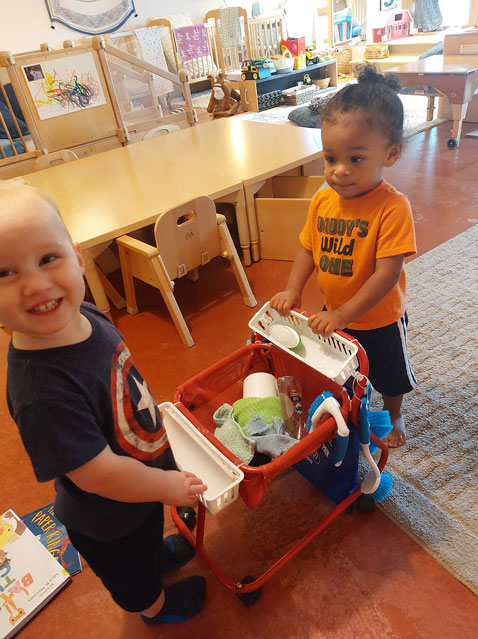
The project was shared with parents via email and through our display of project pictures (see Figure 9). We also collaborated with other teachers who were conducting a similar project, sharing some of our resources and supplies.

Teacher Reflection
This was the first successful project that we as a co-teaching team did with our group of children, so we gained very valuable experience. We mainly learned to keep our expectations very flexible and to follow the lead of our children. We recognized, as with many things involving this age group, the relationship teachers build with their children truly provides the foundation required to do project work like this. Understanding our children and their interests allowed the project to unfold very authentically.
We were surprised by how long the project lasted, given the young age of the children. We had tried another project earlier in the spring with the same group that fizzled out in about two weeks. The topic was “vehicles.” We noticed our children gravitating toward toy cars, pointing out cars in the parking lot, and pretending to drive in our classroom, so we began a project. Looking back on why this project didn’t progress, we realized that cars/vehicles are not a tangible, physical item in their immediate world that they could interact with fully.
Comparing this with our cleaning project that lasted about two months, with consistent, sustained interest and engagement throughout, we learned that this very young age group needs project work that is very literal and tangible. We closely monitored the interest of our children and let the project naturally come to an end as we noticed engagement fade. We still have a lot of the cleaning materials available to the children, and some of them still use them frequently.
Our topic started with strong interest because it was grounded in a daily classroom routine and involved many tools for exploration that children had observed, but not explored. It provided enough flexibility to adjust and change with the interest of this very young age group. We were able to provide meaningful experiences to the entire range of ages we work with . At first, we were going to select a single cleaning tool to focus on, but with the attention span and particular group of children we were working with, it made most sense to keep the topic more open.
One of our 1½-year-old children who sparked the initial interest in the topic kept the momentum going through the project and especially benefited from the experience. He observably loves cleaning and truly led the project and his peers in ways that we had not observed in him prior to this experience. Giving him opportunities to explore a subject he was very interested in helped him grow in many positive ways.
As a result of this project, the children gained independence, responsibility, cleaning skills, growth, and confidence. Giving children the same tools and responsibilities that they observe their teachers using as well as providing open-ended, child-centered, authentic experiences were invaluable to the success of this project.


